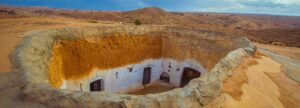Formerly an important Islamic center in North Africa
Kairouan is the fourth city of Islam after Mecca, Medina and Jerusalem. It was founded in 670 AD by a follower of the Prophet Mohammed. It is said that seven visits to Kairouan are like driving to Mecca. The forecourt of the Great Mosque in Kairouan (which can also be visited) is said to be able to accommodate up to 200.000 pilgrims on holy days.
The prayer room is supported by a multicolored forest of columns from Roman, Byzantine and Arab times. The 5 m high, artistically carved wooden pulpit dates from the 9th century, as does the minaret with 128 steps. As a religious center, the city with 300 mosques, zaouias and marabouts is an important attraction for foreigners such as Tunisians and a day stop for every round trip.
The picturesque medina (old town) is completely enclosed by a 3,5 km long defensive wall made of brown adobe bricks, which was built in 1052 and rebuilt to a much smaller extent at the beginning of the 18th century after it was destroyed by the Turks. The modern new town spreads out at the gates of the city. With the medina and its markets organized according to guilds according to oriental tradition, its mosques and sacred buildings, Kairouan has been on the UNESCO list of world cultural heritage since 1988.
Today, Kairouan, together with the new town, has almost 100.000 inhabitants. In addition to agriculture, tourism is an important branch of the economy, several thousand visitors come every day. Together with the traditional trades of silk and blanket weaving, leather production and carpet weaving, this enables a modest prosperity.






